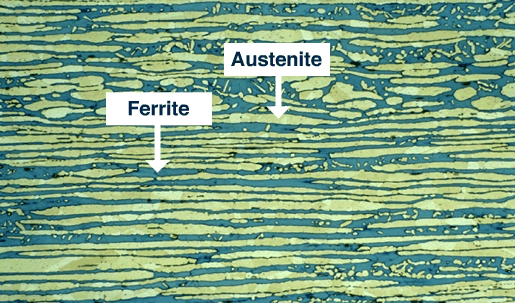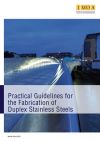
Duplex stainless steels have a two-phase microstructure of austenite and ferrite grains (Courtesy of Outokumpu).
Since the mid 1990s the use of duplex stainless steel (DSS) has grown substantially and many new duplex grades have been developed. Although the abundance of new duplex grades provides users with more material options, the lack of availability of some of the newer grades in all product forms can be an issue. Because the levels of nickel and molybdenum are reduced compared to an austenitic grade with similar corrosion resistance, the duplex grades tend to be less expensive than their austenitic counterparts.
With their high yield strength, the required section thickness for tanks and pressure vessels can often be reduced with duplex stainless steel construction, resulting in substantial cost savings. In order to avoid precipitation of the undesirable alpha prime in the ferrite phase, most duplex grades have a maximum service temperature of 315°C (600°F).
The duplex grades are used widely across all industry sectors. The primary factors that drive the use of duplex stainless steels are their improved stress corrosion cracking resistance and the potential to reduce cross sections in high-stress or high-pressure applications and tank construction. As with the other stainless steel families, the duplex grades have a range of corrosion resistance and can be divided into subgroups, depending on alloying content.
Lean duplex stainless steels: The lean duplex grades such as LDX 2101® (S32101), UR 2202 (S32202), ATI 2102® (S82011) and 2304 (S32304) are characterized by relatively low levels of nickel and/or molybdenum. To compensate for the reduced nickel content, which is a strong austenite former, these grades have increased levels of nitrogen and manganese, which provide an acceptable austenite/ferrite phase balance. As a group the lean grades have high strength, particularly yield strength, and exhibit a pitting and crevice corrosion resistance that is similar to, or just below that, of the Type 316L austenitic grade. Because of their relatively high yield strength, the lean DSSs are well suited for tank construction and structural applications.
Standard duplex stainless steels: The standard duplex grades typically contain 21-25% chromium, 2-3% molybdenum and 0.15% nitrogen. Grades in this category are used widely across all industry sectors and 2205 (S32205) has become by far the most widely used duplex grade. The 2205 grade has a yield strength that is more than twice that of Type 316 and a pitting and crevice corrosion resistance that is similar to Type 904L austenitic stainless steel. Applications for standard duplex grades include tanks, piping, process vessels and structural applications.
Super duplex stainless steels: The super duplex stainless steels typically contain 25% chromium, 3.5-4.0% molybdenum, and 0.25-0.27% nitrogen. The pitting and crevice corrosion resistance of the super duplex grades are essentially equivalent to the 6% Mo super austenitic stainless steels. The most widely used super duplex stainless steel grades are the 2507 (S32750) and Z100 (S32760) grades. Common applications include piping, heat exchangers, tanks, and process vessels used for chemical processing and marine applications.
Hyper duplex stainless steels: The hyper duplex stainless steels, S33207 and SAF S32707 are the most highly alloyed of the duplex family and contain 26-30% chromium, 3.5-5.0% molybdenum, and 0.30-0.50% nitrogen. The hyper duplex grades are designed for more aggressive acid and chloride-containing environments. They are produced in limited quantities and are currently only available as seamless tubing.
Notes:
Additional Resources
There are various resources available on IMOA’s website to assist on the selection, use and fabrication of duplex stainless steels. These include the following:
Practical Guidelines for the Fabrication of Duplex Stainless Steels
Recently added: 3rd edition, English version
Articles on the application of duplex stainless steels


